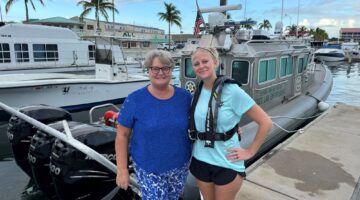Five Deadly Days
By Mark Howell
Midway through hurricane season is as good a time as any to ponder whether “health-care murder” occurred in August 2005 during Hurricane Katrina in New Orleans.
A book released back in February this year suggests “yes” and has been stirring up its own storm ever since.
“Five Days at Memorial: Life and Death in a Storm-Ravaged Hospital” by Sheri Fink (published by Atlantic) paints a hair-raising picture of what really went on at New Orleans’ Memorial Medical Center, which held 238 patients when the levees broke.
Also bunkered in the hospital at the time were 600 doctors, nurses, administrators, therapists, pharmacists, technicians, cooks, janitors and security guards, who all chose to stay — many of them bringing family members and pets with them. The total number amounted to at least 2,000 people and 100 cats and dogs. They stayed because the roads out of the city were clogged and there was no public transportation.
In an article about “Five Days at Memorial” in the London Review of Books last month, reviewer Deborah Friedell describes how the hospital’s Emergency Preparedness Committee had met every year to talk through 47 different scenarios, including volcanic eruptions (there are no volcanoes in Louisiana) and a “VIP situation” such as an injured head of state. After 9/11, it put together a plan more than 100 pages long for dealing with a bioterrorist attack; but “its plan for a hurricane was 100 pages long and useless.”
When the city’s electricity failed during Katrina, so did Memorial’s emergency generator, located several feet below sea level. Foul water rose eight feet high, refrigerators and elevators stopped working, the morgue flooded, the temperature rose to 104° and the stench of human and pet excrement became inescapable. The staff began to stop thinking of the place as a hospital.
Anna Pou, an otolaryngologist, was seen carrying “a handful of syringes” and a doctor overheard her telling patients: I’m going to give you something to make you feel better.” The doctor who saw her remembered it because it was odd: “nobody walks around with a handful of syringes and goes and gives the same thing to each patient. It’s not how we do it.”
Outside the hospital, New Orleans’ residents were clinging to rooftops and drowning in attics and rescue crews were overwhelmed. By the time the Coast Guard finally evacuated the last living person at Memorial on Sept. 2, 45 patients had died, far more than at any other hospital in New Orleans. Twenty-three of them were found to have been injected with high doses of morphine and sedatives, “probably the reason for their deaths,” writes Friedell, “but the bodies were recovered after a week in high temperatures and it was hard to tell.”
In a television interview, Anna Pou denied that she’d killed any patients, only that she’d eased their pain. She also said that the patients who died had all been close to death before the storm hit. Yet, Emmett Everett had been at Memorial awaiting a colostomy. On the morning of his death, he had fed himself breakfast and asked nurses to make sure he wasn’t left behind. But he was a quadriplegic who weighed 380 pounds; “no-one was going to help carry him up the stairs to a helicopter or down to a boat,” writes Friedell.
Most of the other dead patients were elderly residents of the hospital’s long-term acute care unit; some were dependent on ventilators, but when the storm hit, none had been considered in immediate danger of dying.
Many of the Memorial staff later blamed Tenet Healthcare, the highly profitable Texas corporation that owned the hospital, for “abandoning them.” The year before Katrina, Tenet had paid $395 million to settle claims that doctors had performed unnecessary heart operations for profit. In 2006, it paid $900 million to settle a federal case for Medicare fraud and overbilling. A similar hospital called Tulane, reports “Five Days at Memorial,” also lost power during the hurricane but it had paid for private helicopters and buses to get everyone out early and didn’t lose any patients. Tenet put its resources elsewhere: $29,000 in campaign contributions to the senior Louisiana Senator’s aunt to represent Tenet as a lobbyist.
Meanwhile Venezuela’s Hugo Chavez offered to send Louisiana a planeload of aid workers and Cuba’s Fidel Castro to send doctors. Condoleezza Rice, meanwhile, was spotted in Manhattan, shoe shopping at Ferragamo. In the words of a TV news channel at the time, “The United States of America was nowhere to be found.”
The book concludes with a disturbing observation: “Most American hospitals are still fundamentally unprepared for natural disasters … During Superstorm Sandy in 2012, after everything we should have learned from Katrina, we saw hospitals lose power in New York City, hospitals being evacuated in the middle of a hurricane, ICU babies being taken out by hand by hand down darkened staircases, hospitals that knew they had vulnerabilities not evacuating in advance. At Bellevue, the oldest public hospital in the country had to form a human chain up 13 flights of stairs to deliver fuel to a faulty generator.
Only one building in lower Manhattan did not go dark: Goldman Sachs.
Quote for the Week:
“And mama said, why don’t newscasters cry
When they read about people who die?
“At least they could be decent enough
To put a tear in their eye.
“It’s just make believe, Mama said.”
— “The News” by Jack Johnson
[livemarket market_name="KONK Life LiveMarket" limit=3 category=“” show_signup=0 show_more=0]








What happened in New Orleans is a metaphor for the entire eight years of the George W. Bush administration. Incompetence followed by arrogance and knee-jerk failure to just about every challenge it faced. I will not see a recovery from it in my lifetime and sadly, my children may not either.